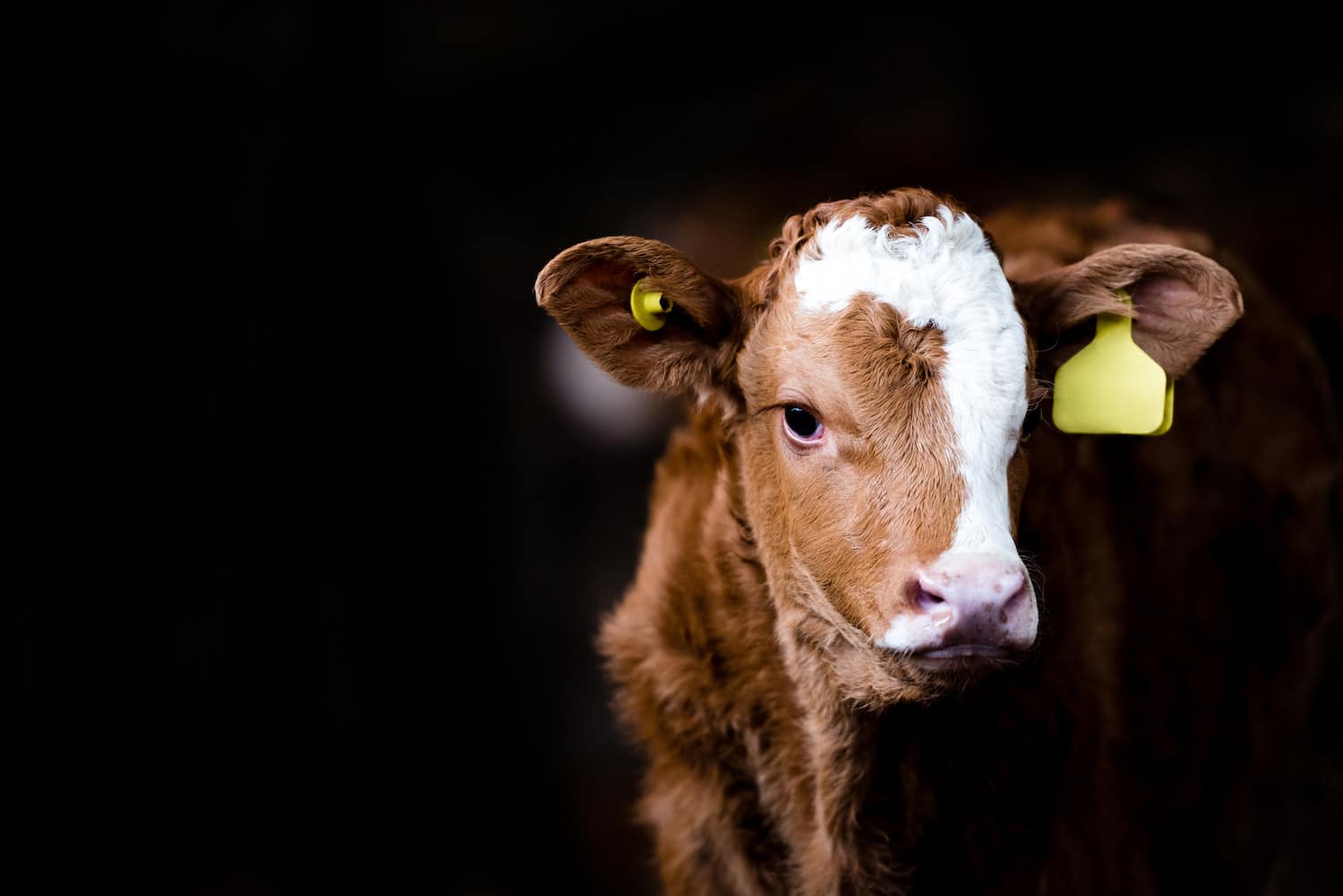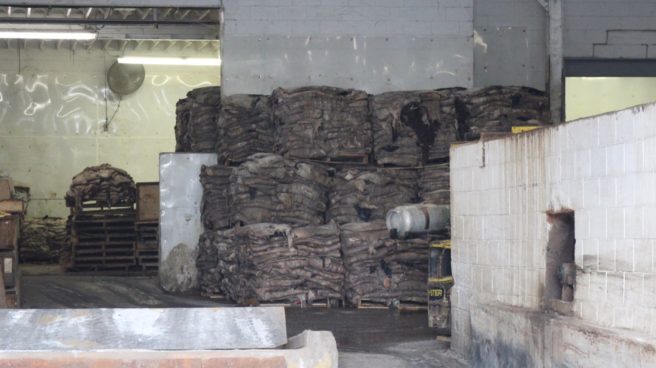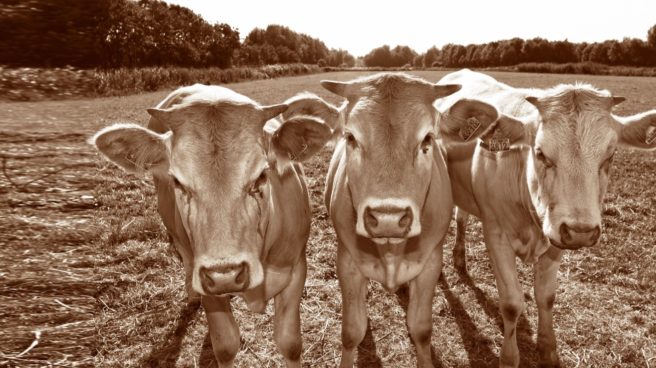
Welcome
This eCourse is designed to help you integrate the information in the post “Is Leather a Byproduct of the Meat Industry?“
Learn about where leather comes, what leather is made of, whether leather supports animal cruelty, and the environmental devastation and public health threat of leather production.
Course Video & Article
It’s obvious that animals have to die for their skin to be made into leather. But if they’re being killed anyways for their meat, isn’t leather just a way of being less wasteful? While even many non-vegans object to the fur industry, the ethical line about leather is far less clear. Is leather truly a byproduct of the meat industry? tweet this
To answer that question, we’ll be answering others you didn’t even know to ask. Like, do you know what country your leather was made in? Do you even know which animal it’s made from? And, did you know there’s a chance it’s a cat or dog?
What Is Leather Made Of?
Before we dive into whether leather is a byproduct of the meat industry, let’s cover where leather comes from.
Leather is made from the hide or skin of animals. Most people associate leather with cow skin, which does make up the majority of leather produced.1
However, many other animals’ skins are turned into leather, including buffalo, sheep, goats, pigs, horses, kangaroos, deer, and even cats and dogs—which we’ll get to later in this article.
There are also so-called “luxury” and “exotic” leathers made from the skin of animals like calves, ostriches, alligators, sharks, elephants, lizards, stingrays and zebras.
Is Leather a Byproduct of the Meat Industry?
Leather production is not about minimizing waste—it’s about maximizing profit.
tweet this— Emily Moran Barwick
As most cow skin leather is derived from cows either slaughtered for their meat, or after their bodies give out from the demands of the dairy industry, it’s generally thought that leather is purely a byproduct of the meat and dairy industries. Companies even use this claim to insinuate that their leather products help reduce waste. After all, isn’t it better to use as much of a slaughtered animal as possible?
While this argument seems quite logical on the surface, it’s entirely inaccurate. Far from an incidental, secondary product made during the production of meat, leather is a multi-billion dollar global industry. The leather goods market was valued at $407.2 billion in 2021, and is projected to grow to $743.50 billion by 2030.2 Leather production is not about minimizing waste—it’s about maximizing profit.
Leather is more accurately termed a coproduct rather than a byproduct of the meat and dairy industries.
Without the sale of leather, the cost of meat would have to increase significantly to make up for lost profits. Even just a reduction in cow skin sales results in multi-million dollar losses for a slaughterhouse.3 The economics of these industries are inextricable—they arguably cannot sustain themselves independently of one another.
Additionally, not all leather is even a coproduct of the meat and dairy industries.
Does All Leather Come from Animals Slaughtered for Meat?

As I mentioned earlier, so-called “luxury” and “exotic” leathers come from animals killed primarily or even solely for their skin. These animals may be illegally poached, even when endangered.
In Myanmar, for example, the Smithsonian Conservation Biology Institute found that endangered Asian elephants were increasingly being poached “for their skin instead of…ivory”.4
While exotic skins—like ostriches, tigers, alligators, sharks, elephants, lizards, stingrays, zebras, and countless others—are a minority of the leather industry purely by volume, they fetch a much higher price point than cow skins. Some are hunted and poached in the wild while others are commercially farmed.
An investigation into alligator and crocodile farms supplying the luxury brand Hermès, creator of the iconic Birkin bag, found deplorable conditions and barbaric, ineffective slaughter practices.5
Not all “luxury” leathers are exotic. The skin of newborn calves is highly valued for its softness. Calves are even cut out of their mother’s wombs at slaughterhouses to have their beating hearts pierced to harvest bovine fetal serum6—another coproduct—and their skins removed for “luxury” items.
While even many meat-eaters draw an ethical line at eating veal, consumers still purchase calfskin products. With a decrease in demand for veal, calfskin becomes more and more of a primary product.7
Where (and Whom) Does Your Leather Come From?

Consumers have become more aware of and concerned about the treatment of animals killed for food, increasingly selecting so-called “humane” options like cage-free eggs and free-range meat—which, to be clear, are not at all humane. However, this consideration rarely enters the conversation when it comes to leather products.
Even more unquestioned is whether the species of animal skin is accurately labeled.
Much of the world’s leather comes from China, which has no comprehensive animal welfare laws,8 and India, where the existing laws are poorly enforced.9 Again, the existence of animal welfare laws does not equate to humane treatment. There is no way to acceptably exploit and kill sentient beings.
However, most consumers are unaware of the egregiousness of the cruelty inflicted upon the beings from whom their leather products were derived.
Investigations into India’s leather trade found that cows who collapse from exhaustion while being marched to slaughter without food or water “have their eyes smeared with chili peppers and tobacco and their tails broken in an effort to keep them moving.”10
Is Your Leather Actually Dog or Cat Skin?

In China, the leading global producer of leather, dogs and cats are also brutally killed for their skin, which is deliberately mislabeled and sold around the world.
While the United States technically banned the importation of dog and cat fur and skin,11 it’s impossible to effectively enforce given the difficulty of distinguishing the difference.
Investigations into China’s dog slaughterhouses captured dogs being bludgeoned with a wooden pole, often remaining conscious even after their throats were slit and their skin ripped from their bodies.12
Not only are leather products deliberately mislabeled when it comes to the species, but it’s also not possible for consumers to necessarily know the country of origin. If an animal was skinned in China, but that skin was imported by Italy where the end product was manufactured, the label will indicate it was made in Italy.
Does Purchasing Leather Support Animal Cruelty?
Even in the most “ideal” conditions, it’s impossible to say that any animal product, coproduct, or even byproduct does not support overt cruelty.
tweet this— Emily Moran Barwick
Along with the misconception that purchasing leather helps reduce waste, viewing most leather as a byproduct of the meat and dairy industries also allows consumers to believe they aren’t supporting the cruelty inherent within those industries. However, as we’ve now seen, this simply isn’t true.
We’ve covered how leather from the meat and dairy industries is a profitable coproduct, creating a complete economic interdependency.
We’ve covered how not all leather comes from animals slaughtered for their meat. And we’ve now learned that most leather products come from countries without even the most basic of animal welfare legislation or enforcement, and may even be the skin of cats and dogs.
But let’s say for the sake of argument that we are talking about cow skin leather from the meat and dairy industries within the United States or the European Union—which supposedly has strong animal welfare regulations.
Does purchasing that very specific leather support animal cruelty? To answer this question, I’ll give an incredibly high-level summary of the treatment of cows within these industries under the supposedly highest standards.
The Treatment of Cows in the Meat & Dairy Industries (with Strong Regulations)

Without any form of pain relief or anesthetic, cows within the meat and dairy industry undergo legally sanctioned mutilations like dehorning and castration.13 Cows are forcefully impregnated through artificial insemination14—a process that can be physically damaging, especially when considering that most inseminations are performed by non-veterinarians.15 Bulls are repeatedly subjected to painful electroejaculation.16
In the dairy industry, no matter the country, babies are taken from their mothers after birth. Cows bond intensely with their babies and mother cows will cry for days until their voices are hoarse.17
We’ve already discussed what happens to the male calves. Most females are kept to eventually replace their mothers, though some are sent to meet the same fate as the males.18
This cycle of forced impregnation and traumatic separation is repeated over and over again until dairy cows’ bodies give out entirely around age four or five, despite having a natural lifespan of 20 years or more.
At the slaughterhouse, even in the “best” of conditions, a significant number of cows are ineffectively stunned with a captive bolt gun.19 This in combination with the pressure to keep the line moving often results in cows being conscious during slaughter and even as their skin is removed.20
Additionally, the vast majority of animal welfare regulations contain exceptions for animals undergoing halal and kosher ritual slaughter, mandating that they be allowed to be killed without any stunning.21 For an in-depth look into halal and kosher slaughter, please see my video and article “Are Halal And Kosher Slaughter Humane?“
Even in the most “ideal” conditions, it’s impossible to say that any animal product, coproduct, or even byproduct does not support overt cruelty. No animal wants to be killed.
A Note on the Environmental Impact, Public Health & Labor Issues of the Leather Industry

Aside from all of the economic, logistical, and ethical reasons that leather cannot rightly be viewed as a byproduct, the leather industry is responsible for profound environmental devastation entirely independent of the meat and dairy industries.
The extreme toxicity of leather production also endangers the lives of tannery workers and those in surrounding communities. These issues deserve their own dedicated videos and articles, which I plan to produce in the future. For now, I will provide a very high-level summary. Please see the citations within this section for further resources.
The environmental impact of the meat and dairy industries themselves is astronomical. On top of this destruction, most leather is tanned with toxic chemicals like chromium, formaldehyde, arsenic, and other heavy metals, all of which are dumped into waterways.22
Not only does this water pollution kill the fish and other species within the water, but it also poisons any species that enters or drinks from the water—including humans.23 Tannery workers and people in communities surrounding tanneries face a myriad of health issues, including increased cancer rates, leading to what have been termed “cancer villages”.24
Leather’s environmental impact also extends to the deforestation caused by raising cows, especially in Brazil, the world’s third-largest producer of cow skins. The “cattle” industry is the single largest cause of tropical deforestation in the Amazon and globally.25 The vast majority of Amazonian deforestation is done illegally.26
Research by Stand.earth released in 2022 documents over 100 fashion brands—many well-known like Adidas, Nike, Coach, Prada—”have supply-chain links to Brazilian leather exporters…known to engage in Amazon deforestation.” European auto manufacturers like VW, BMW, Daimler, PSA and Renault have also been linked to illegal deforestation for the leather used in their cars.27
Final Thoughts & Vegan Leather Alternatives
I think at this point it’s safe to say that leather is far from a harmless, waste-reducing byproduct of the meat industry. With the abundance of vegan leather alternatives, which I’ve covered in a dedicated article, there’s simply no reason to continue supporting such a cruel and environmentally devastating industry.
Please do share this with anyone wondering what’s so wrong with leather? And remember to take the free eCourse! To support educational content like this, please consider making a donation. Now go live vegan, and I’ll see you soon.
— Emily Moran Barwick
Open the accordion above to view the course video and article. Then take the quiz to test your knowledge of the information covered! You may take the quiz an unlimited amount of times. Passing score: 80%
"*" indicates required fields







